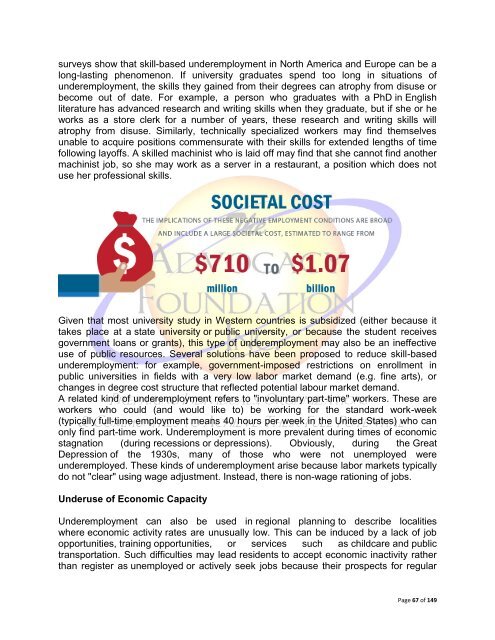Hidden Unemployment
Hidden Unemployment
Hidden Unemployment
You also want an ePaper? Increase the reach of your titles
YUMPU automatically turns print PDFs into web optimized ePapers that Google loves.
surveys show that skill-based underemployment in North America and Europe can be a<br />
long-lasting phenomenon. If university graduates spend too long in situations of<br />
underemployment, the skills they gained from their degrees can atrophy from disuse or<br />
become out of date. For example, a person who graduates with a PhD in English<br />
literature has advanced research and writing skills when they graduate, but if she or he<br />
works as a store clerk for a number of years, these research and writing skills will<br />
atrophy from disuse. Similarly, technically specialized workers may find themselves<br />
unable to acquire positions commensurate with their skills for extended lengths of time<br />
following layoffs. A skilled machinist who is laid off may find that she cannot find another<br />
machinist job, so she may work as a server in a restaurant, a position which does not<br />
use her professional skills.<br />
Given that most university study in Western countries is subsidized (either because it<br />
takes place at a state university or public university, or because the student receives<br />
government loans or grants), this type of underemployment may also be an ineffective<br />
use of public resources. Several solutions have been proposed to reduce skill-based<br />
underemployment: for example, government-imposed restrictions on enrollment in<br />
public universities in fields with a very low labor market demand (e.g. fine arts), or<br />
changes in degree cost structure that reflected potential labour market demand.<br />
A related kind of underemployment refers to "involuntary part-time" workers. These are<br />
workers who could (and would like to) be working for the standard work-week<br />
(typically full-time employment means 40 hours per week in the United States) who can<br />
only find part-time work. Underemployment is more prevalent during times of economic<br />
stagnation (during recessions or depressions). Obviously, during the Great<br />
Depression of the 1930s, many of those who were not unemployed were<br />
underemployed. These kinds of underemployment arise because labor markets typically<br />
do not "clear" using wage adjustment. Instead, there is non-wage rationing of jobs.<br />
Underuse of Economic Capacity<br />
Underemployment can also be used in regional planning to describe localities<br />
where economic activity rates are unusually low. This can be induced by a lack of job<br />
opportunities, training opportunities, or services such as childcare and public<br />
transportation. Such difficulties may lead residents to accept economic inactivity rather<br />
than register as unemployed or actively seek jobs because their prospects for regular<br />
Page 67 of 149

















